
By Joyce Coronel, The Catholic Sun
PHOENIX — When Bishop Thomas J. Olmsted drives away from the Diocesan Pastoral Center after more than 18 years at the helm of the Phoenix Diocese, he’ll leave in his wake a panoply of achievements in the world of politics, education, and culture.
The nine years he spent working at the Vatican’s Secretariat of State with St. John Paul II deeply impacted him and the effects are demonstrable throughout the Diocese of Phoenix. What many will recall is his fervent devotion to Evangelium Vitae, the Gospel of Life, the encyclical written by St. John Paul II in defense of the dignity of human life.
A leader on life issues
Ron Johnson, executive director of the Arizona Catholic Conference, the policy arm of the Catholic bishops of Arizona, said Bishop Olmsted has long been a recognized leader in the pro-life movement.
“One need only harken back to when he first arrived. The prayers outside Planned Parenthood were really his first public act,” Johnson said. “People thought he was making a very special statement, which in a way he was, but what they didn’t know was, that’s what he does all the time.”
During his tenure, Americans United for Life named Arizona the most pro-life state in the country, Johnson said. “And Bishop Olmsted would have a lot to do with that, in my opinion.”
From rosaries offered every year in front of Planned Parenthood on Christmas Eve and Good Friday to blessing ultrasound machines and helping fund pro-life pregnancy centers through the Charity and Development Appeal, Bishop Olmsted has been a fierce defender of the right to life and the dignity of women. He supported 40 Days for Life, a prayer campaign that takes place twice a year and that nationally has helped to peacefully close 116 abortion clinics and save over 20,000 babies’ lives.
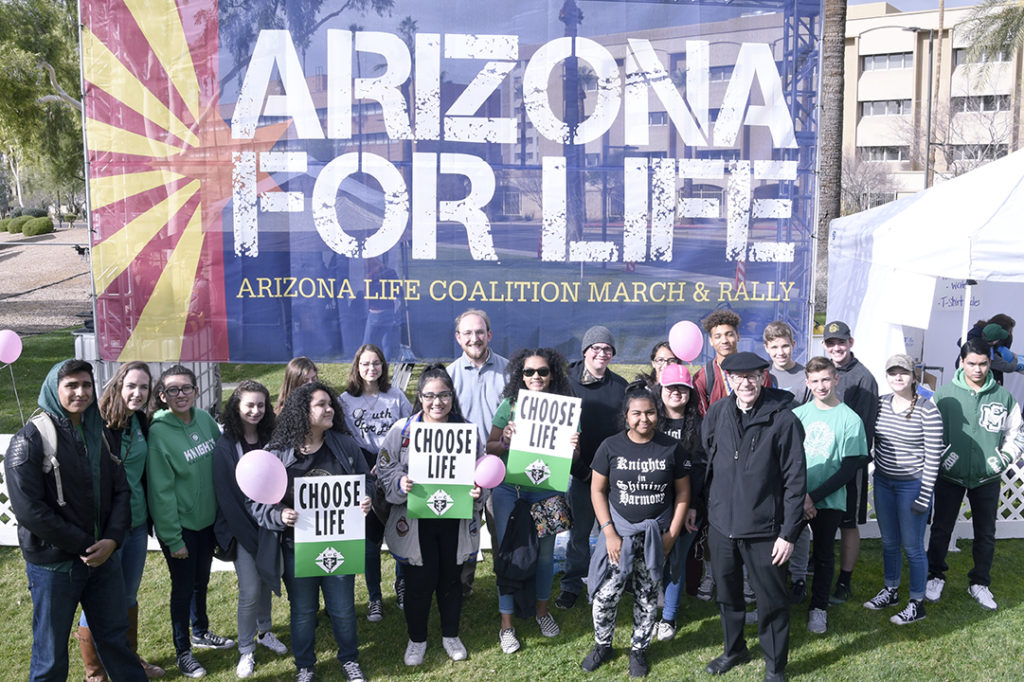
Sheila Riley, director of Life Choices Women’s Clinics, had words of praise for Bishop Olmsted’s leadership on the life issue.
“I didn’t know who Bishop Olmsted was before he was moved to Phoenix. Nevertheless, he was an answer to prayer,” Riley said. His commitment to praying outside abortion providers was greatly appreciated by pro-life leaders.
“Since the very first Christmas when he was installed as bishop, he has been coming to the abortion clinic, with only a couple years off during [the COVID-19 pandemic]. He’s just been very dependable on both Good Friday and Christmas Eve. Rain didn’t stop him,” Riley said.
John Jakubczyk, who led Arizona Right to Life for years, admires Bishop Olmsted’s commitment to the pro-life cause.
“With his boldness, his courage, his willingness to say the truth and to call people to account and call us to get involved,” Jakubczyk said, “he made a difference. His homilies and his presentations were incredible. You never wanted him to stop, you just wanted him to keep talking because he was so good.”
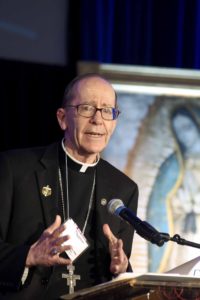
Leading voice on immigration
Tommy Espinoza, president and CEO of Raza Development Fund, a firm that serves the Latino and marginalized community, offered words of praise for Bishop Olmsted’s commitment to solidarity with Hispanics. Espinoza is also on the national board for Catholic Association of Latino Leaders. CALL is a non-profit organization devoted to the growth and spiritual formation of Latino leaders who are poised to impact the community as well as the business, professional and education worlds.
“I don’t think people realize that Bishop Olmsted was one of the founders of that organization,” Espinoza said. “He has been involved with our community from the very beginning of his coming to Phoenix.”
Back in 2003, when Bishop Olmsted arrived in Phoenix for his installation, the state was in the midst of a fierce debate over immigration.
“The political atmosphere was really bad. There was a great deal of anxiety and fear in the hearts of our community,” Espinoza said. “The important part that we explained to Bishop Olmsted is that immigrants felt safe at the Catholic Church, at our churches.”
The ensuing discussion centered on how to engage the Latino community and make them feel part of the diocese. With Our Lady of Guadalupe as the patroness of the Phoenix Diocese, the idea was to come up with a way for the whole Latino community to come together and honor the Virgen de Guadalupe. Honor Your Mother, a colorful annual event that draws throngs, was born.
“Bishop personally was involved in all the meetings that we had, planning the event, and, fast forward to this last one in 2021, it was a big success,” Espinoza said.
As for the controversy over immigration, Espinoza said, Bishop Olmsted was not reticent about taking a stand.
“I believe he was one of the early voices, not just talking about immigration but actually writing a position paper,” Espinoza said.
On Dec. 12, 2005, the feast of Our Lady of Guadalupe, Bishop Olmsted, along with his three brother Arizona bishops, released You Welcomed Me, a pastoral letter that dealt with the roiling controversy over immigration and called for comprehensive reform of the nation’s laws.
“We believe that Arizona can lead our country toward a solution to this crisis,” the letter stated. “We can build on our common ground and our shared values as Catholics to develop, along with others in our community, a solution that protects the dignity of the migrants among us, strengthens our communities, makes us safer as a nation, and builds on the great immigrant heritage of our country.”
“The paper and the position that Bishop Olmsted took — I’ll use the term gutsy, in a very politically charged state. Let’s face it. It was not a favorable discussion even amongst Catholics, let alone Latinos.”
Between his embrace of the Hispanic community and championing of the pro-life cause, Espinoza said, Bishop Olmsted endeared himself to Latinos.
“Within the Latino community, he’s very highly respected and loved.”
Johnson, for his part, also emphasized Bishop Olmsted’s concern for immigrants.
“He has special concerns for those who are here and who have families, where one spouse may be here as a citizen and the other is not, and they’ve got kids,” Johnson said, while adding that Bishop Olmsted’s leadership on immigration has helped people to consider the humanity of those who have fled their homeland.
Defending marriage
In 2006, Arizona voters first had the opportunity to enact an amendment to Arizona’s Constitution to preserve the definition of marriage as pertaining to one man and one woman. Catholics in the Public Square, a book by Bishop Olmsted, had just been published.
The tome, part of the Shepherd’s Voice series, addressed what it called the “non-negotiable issues” for Catholics. These issues, involving intrinsic evil, include protection of life in all its stages, from the first moment of conception to natural death, and the one-man, one-woman nature of marriage.
Arizona Proposition 107 was defeated in 2006, but supporters didn’t give up.
When the Protect Marriage Initiative, Prop 102, came before voters again in 2008, there was another edition of Catholics in the Public Square released (there are close to 400,000 in circulation now), but there was also a video featuring Bishop Olmsted that was shown in all the parishes in the diocese.
Johnson, the lobbyist for Arizona Catholic bishops, still has the eyebrow-raising data on the ensuing shift in Catholics’ views on the marriage initiative.
“Basically, it showed church-going Catholics moved almost 40 percentage points after that video up until the time of the election. So, we were able to inspire people, especially church-going Catholics, by Bishop Olmsted’s very clear, loving messages,” Johnson said.
Prop 102 was approved by 56 percent of Arizona voters in 2008, carrying every county except Pima. Even though the U.S. Supreme Court would ultimately legalize same-sex marriage throughout the nation, the broad victory in Arizona’s 2008 election was still impressive.
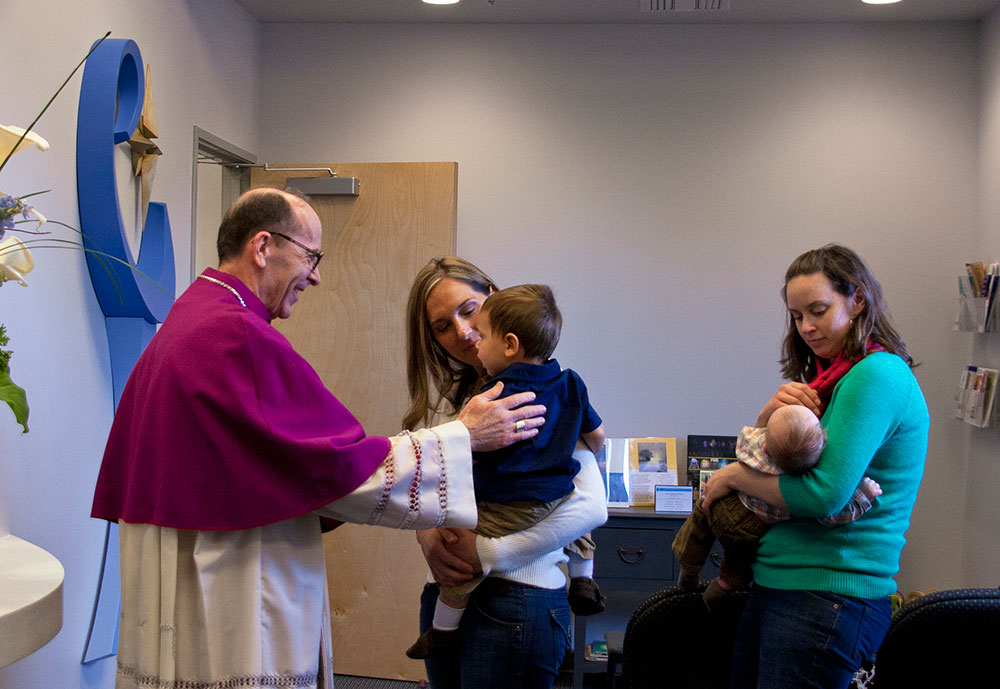
Resource center founded to support marriage
Early in his term, on Jan. 30, 2006, Bishop Olmsted, along with Fr. Charles Goraieb, founded the John Paul II Resource Center for the Theology of the Body and Culture, devoted to advancing the Gospel of Life and God’s plan for marriage. Mike Phelan, director of the Office of Marriage and Respect Life for the Diocese of Phoenix, called the center a “tremendous gift.”
The John Paul II Resource Center “gives us the intellectual grounding for making the beautiful case for a culture of life and the dignity of every single human person made male and female in the image of God,” Phelan said.
The center promotes Pope St. John Paul II’s Theology of the Body “at every level of catechesis and evangelization in the diocese so that we have confidence in the Church’s teaching about the nature of the person,” Phelan added.
Bishop Olmsted began his nine-year term working at the Vatican with Pope St. John Paul II the same week that the late pontiff began his Wednesday audiences now known as the Theology of the Body.
Fr. John Nahrgang, Vicar for Evangelization and Education for the Diocese of Phoenix, weighed in on how he believes spending time with the saint impacted Bishop Olmsted.
“He had a court-side seat and was a witness right on the frontlines for what Pope John Paul II was doing in the area of human sexuality, family, and marriage from the very beginning, so he was in a privileged position to understand his outlook and see it develop and mature and expand and have the huge impact that it had,” Fr. Nahrgang said.
“Fast forward, he becomes a bishop, and he had the whole game plan, at least intellectually and theologically, to unleash all of that wisdom in a diocese.”
Read Bishop Olmsted’s 2012 series on marriage, The Blessings of a Fruitful Life
Supporting Catholic education
Not the least of Bishop Olmsted’s accomplishments was the establishment of five new Catholic schools, including a new Catholic high school in the far west Valley, even as dioceses around the nation were shuttering schools and institutions. St. John Paul II High School opened in 2018, and the crucifixes on the classroom walls aren’t merely window dressing — they point to the core principles of the school and Bishop Olmsted’s 2017 pastoral letter, Evangelizing through Catholic Schools.
In the letter, the bishop called Catholic schools a focal point in evangelization. Domonic Salce, Superintendent of Catholic Schools, agreed that evangelization of students is a centerpiece of schools in the diocese.
“Bishop Olmsted emphasizes that first and foremost. He wants people to get closer to Christ,” Salce said.
“We’ve focused all of our activities, whether it’s curriculum, extracurricular with sports or art or robotics or whatever else, on that personal relationship with Jesus.”
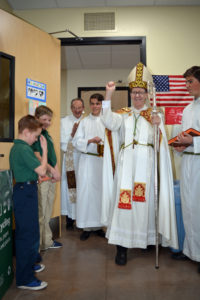
The spotlight on evangelization and formation allows students — and by extension their families — to become “missionaries for the faith and missionaries for Christ,” Salce said, adding that even before the pastoral letter, Bishop Olmsted had long been a champion of Catholic education.
“He’s always been, first and foremost, steadfast in terms of how important Catholic education is for our families.”
Bishop Olmsted similarly set his sights on higher education during his tenure. In 2009, he penned Serving Truth in the University, a pastoral letter on Newman Centers and their part in higher education. The letter addressed the crucial role of Newman Centers in “promoting the vital interaction between faith and reason, the two harmonious ways to the truth, which is always one” and in equipping young people to engage in the new evangelization.
The bishop beefed up Newman Centers around the diocese, sending Fr. Rob Clements, once the diocesan director of vocations, to lead the All Saints’ Catholic Newman Center at Arizona State University. He also established Holy Spirit Newman Center at Grand Canyon University in 2016, where Sr. Clare Marie, director of evangelization, has been serving since 2020.
Sr. Clare said Bishop Olmsted invited her community, Servants of the Pierced Hearts of Jesus and Mary, to come to the diocese and help staff the newly established student center. She said the sisters are grateful for Bishop Olmsted’s invitation and his support of the spiritual needs of the young people who studied his apostolic exhortation on the Eucharist, Veneremur Cernui — Falling Down in Adoration, issued in 2021.
“The students came to know the heart of Bishop Olmsted and really came to love him through that,” Sr. Clare said. “They were guided in their spiritual lives by his teaching and by his words.”
When Bishop Olmsted visited Holy Spirit Newman Center this year, six students shared their testimony of how his apostolic exhortation had impacted them. Not long after, they were able to receive their First Holy Communion from him.
In addition to increased support for Newman Centers, Bishop Olmsted’s years of leadership saw the long- anticipated arrival of Catholic higher education, first with University of Mary at Arizona State University in 2012, followed by Benedictine University in Mesa in 2013, Creighton University in Phoenix in 2021, and, more recently, Alverno College’s Nursing Education Center in Mesa in March of 2022.
None of these Arizona-based Catholic higher education options were available prior to Bishop Olmsted’s arrival. Chancellor of the Diocese of Phoenix Dr. Maria Chavira, who spent many years in college education before she was appointed chancellor, said Bishop Olmsted had long desired Catholic higher education in the diocese.
“Definitely I think Bishop Olmsted was an influential person in making sure that we had Catholic higher education,” Chavira said. “And I think one of the biggest things about that is that it offers education through our Catholic lens.”
It’s that Catholic lens that helps students to acquire a Catholic understanding of the human person and who God is calling them to be. It also works as a means of evangelization and disciple-making, Chavira said.
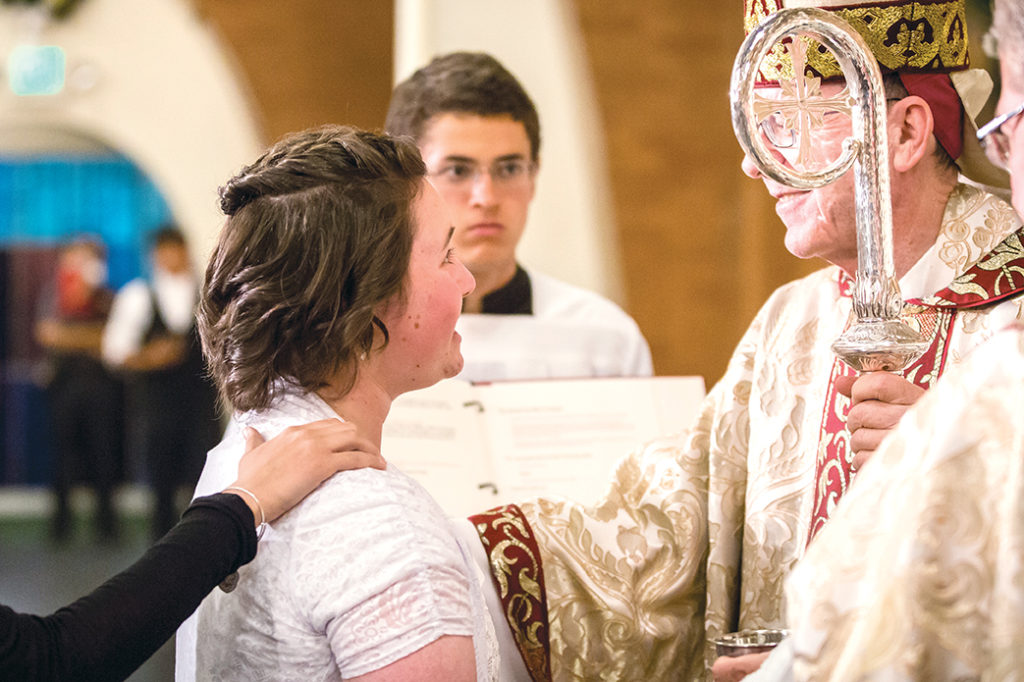
Teaching through writing
Bishop Olmsted took his role as chief catechist and evangelist of the diocese very seriously. His columns in The Catholic Sun were wide-ranging and focused on topics as varied as the mystery of the cross, human freedom, evangelization, infertility, and forgiveness. He also examined papal encyclicals and the lives of the saints, including St. Philip Neri, St. John Newman and Blessed Miguel Pro.
Bishop Olmsted’s writing wasn’t limited to The Catholic Sun, however. He also penned apostolic exhortations such as Complete My Joy, calling parents and families to holiness; Into the Breach, challenging men to establish their lives on God and pursue heroic virtue; and Veneremur Cernui — Falling Down in Adoration, examining the Real Presence of Christ in the Eucharist. The Knights of Columbus organization was so inspired by Into the Breach that it created a 12-episode video series along the same theme. The exhortation itself has been translated into 14 languages and is internationally acclaimed.






